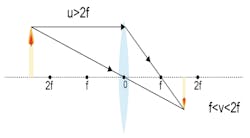Learning Optics with Austin: Lesson 6 – Focal Length and Applications of Lenses
Focal length is important not just in terms of positive and negative. For convex lenses, different focal lengths can have drastically different images. If an object (u) is at a distance greater than two times its focal length (2f), then its image focal length (v) is between f and 2f (written as f < v < 2f). The image will appear upside down and smaller than the object. This is the case for cameras, of which are a primary application of this property.
u > 2f
Camera
If however, the object is at exactly the distance of two times the focal length (u = 2f), then the image focal length is exactly twice the focal length (v = 2f). The image is still upside down, but is the same size as the object. Scanners and printers are primary examples of this application.
u = 2f
Scanner
When the object is at a length less than 2 focal lengths but greater than a focal length (f < u < 2f), the image focal length is greater than 2 focal lengths (v > 2f). While the image is upside down, it is larger than the original object. This property is utilized by projectors in displaying an image much larger than the original object.
f < u < 2f
Projector
If an object is less than a focal length away from the lens (u < f), no real image exists. However, a virtual image does exist and is larger than the actual object. An example of this phenomenon is a magnifying glass which enlarges the image to look bigger than the object itself.
u < f
Magnifying Glass
There is also the case where the object is exactly a focal length away from the lens (u = f). As light runs parallel through the lens at this distance, no image or virtual image exists.
u = f
Every case above has been under the assumption that a convex lens is used. For concave lenses, no matter where you place the object, the image will always be smaller than the actual object. For people with nearsightedness, their glasses are concave lenses. The image through their glasses will always be smaller than the object itself.
Telescope
Optical instruments such as telescopes are not composed of a single lens. Instead, multiple lenses are assembled together to produce the desired optical effect. In the next post, we will be discussing an example of an assembled system and specifications when designing lenses.
About the Author

Austin from Shanghai Optics Inc
Hello! My name is Austin and I am the host for this blog. I graduated from Rutgers in May 2021 with a Bachelor’s degree in Statistics-Mathematics and History. I interned during the summer of 2021 at Shanghai Optics working on data cleaning and analysis. I was later offered to work full-time starting in September. While my initial role was in data analytics, I realized that my knowledge of the company’s products was quite shallow as a key skill for any well-trained data analyst is to know your data. That’s how I got started on my journey in learning about optics.
I found physics interesting but challenging in high school. I did not particularly enjoy classical physics and a seminar in quantum mechanics flew over my head in college. As I see first-hand how our optics works in different applications, I’m quickly beginning to realize that Photonics has the potential to shape the present and the future. Because of my newfound enthusiasm, management took notice and I am fortunate enough to begin a Physics/Photonics class sponsored by Shanghai Optics in the fall of 2021. This blog is part of my experience in taking the class and sharing with you all the wealth of knowledge I’m acquiring!
Aside from optics, some of my personal interests include studying history and going on hikes. Both activities are great opportunities to talk with other people so feel free to ask me any questions on my personal interests or the materials I post!
